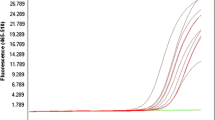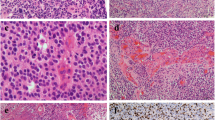Abstract
The purpose of this study was to investigate the relationship between antioxidant enzyme expression and clinicopathological features in 67 ependymal tumors. We included into the analysis antioxidant enzymes (AOEs) and related proteins, such as, manganese superoxide dismutase (MnSOD), gammaglutamylcysteine synthetase catalytic and regulatory subunits (GLCL-C and GLCL-R), thioredoxin (Trx) and thioredoxin reductase (TrxR). Their expression was studied in 46 primary (10 grade I, 30 grade II and 6 grade III) and 21 recurrent (3 grade I, 12 grade II and 6 grade III) tumors. Immunoreactivity for MnSOD was found in 87%, GLCL-C in 74%, GLCL-R in 89%, Trx in 72%, TrxR in 54%, of primary tumors. Lower GLCL-C and GLCL-R expression was associated with higher tumor grade (P = 0.047 and 0.049, respectively). MnSOD, GLCL-C and TrxR expressions were significantly higher in tumors located in the spinal cord compared to those in the brain (P = 0.044, 0.046 and 0.004, respectively). In the primary tumors Trx-positivity was found to correlate significantly with patient survival. In univariate survival analysis patients whose tumors did not express Trx had shorter survival (P = 0.045) and there was even more significant association (P = 0.011) when only adults were included in the analysis (in the total material median follow-up time of Trx-positive tumors was 9.7 years and of Trx-negative 5.4 years). The results indicate that AOEs have several biological functions in ependymal tumors. Trx had important prognostic value: all adults with Trx-positive tumors were alive at follow-up (median 7.8 years).




Similar content being viewed by others
References
Kleihues P, Cavanee WK (eds) (2000) Pathology and genetics of tumours of the nervous system. WHO classification of tumours. IARC Press, Lyon, pp 10–21, 29–44
Jeuken J, Sprenger S, Gilhuis J et al (2002) Correlation between localization, age, and chromosomal imbalances in ependymal tumors detected by CGH. J Pathol 197:238–244. doi:10.1002/path.1086
Korshunov A, Neben K, Wrobel G et al (2003) Gene expression patterns in ependymomas correlate with tumor location, grade, and patient age. Am J Pathol 163:1721–1727
Kinnula VL, Crapo JD (2004) Superoxide dismutases in malignant cells and human tumors. Free Radic Biol Med 36:718–744. doi:10.1016/j.freeradbiomed.2003.12.010
Järvinen K, Soini Y, Kahlos K et al (2002) Overexpression of gamma-glutamylcysteine synthetase in human malignant mesothelioma. Hum Pathol 33:748–755. doi:10.1053/hupa.2002.126191
Kinnula V, Pietarinen-Runtti P, Raivio K et al (1996) Manganese superoxide dismutase in human pleural mesotheliomas cell lines. Free Radic Biol Med 21:527–532. doi:10.1016/0891-5849(96)00049-4
Halliwell B (1991) Reactive oxygen species in living systems: source, biochemistry, and role in human disease. Am J Med 91:14–22. doi:10.1016/0002-9343(91)90279-7
Church SL, Grant JW, Meese EU et al (1992) Sublocalization of the gene encoding manganese superoxide dismutase (MnSOD/SOD2) to 6q25 by fluorescence in situ hybridization and somatic cell hybrid mapping. Genomics 14:823–825. doi:10.1016/S0888-7543(05)80202-2
Li Y, Huang T-T, Carlson EJ et al (1995) Dilated cardiomyopathy and neonatal lethality in mutant mice lacking manganese superoxide dismutase. Nat Genet 11:376–381. doi:10.1038/ng1295-376
Carlsson LM, Jonnson J, Edlund T et al (1995) Mice lacking extracellular superoxide dismutase are more sensitive to hyperoxia. Proc Natl Acad Sci USA 92:6264–6268. doi:10.1073/pnas.92.14.6264
Cobbs CS, Whisenhunt TR, Wesemann DR et al (2003) Inactivation of wild-type p53 protein function by reactive oxygen and nitrogen species in malignant glioma cells. Cancer Res 63:8670–8673
Kahlos K, Anttila S, Asikainen T et al (1998) Manganese superoxide dismutase in healthy human pleural mesothelium and in malignant pleural mesothelioma. Am J Respir Cell Mol Biol 18:570–580
Kahlos K, Pääkkö P, Kurttila E et al (2000) Manganese superoxide dismutase as a diagnostic marker for malignant pleural mesothelioma. Br J Cancer 82:1022–1029. doi:10.1054/bjoc.1999.1037
Kahlos K, Soini Y, Pääkkö P et al (2000) Proliferation, apoptosis, and manganese superoxide dismutase in malignant mesothelioma. Int J Cancer 88:37–43. doi :10.1002/1097-0215(20001001)88:1<37::AID-IJC6>3.0.CO;2-3
Haapasalo H, Kylaniemi M, Paunu N et al (2003) Expression of antioxidant enzymes in astrocytic brain tumors. Brain Pathol 13:155–164
Tew KD (1994) Glutathione-associated enzymes in anticancer drug resistance. Cancer Res 54:4313–4320
Zhang K, Mack P, Wong KP (1998) Glutathione-related mechanisms in cellular resistance to anticancer drugs. Int J Oncol 12:871–882
Dalton TP, Dieter MZ, Yang Y et al (2000) Knockout of the mouse glutamate cysteine ligase catalytic subunit (Gclc) gene: embryonic lethal when homozygous, and proposed model for moderate glutathione deficiency when heterozygous. Biochem Biophys Res Commun 279:324. doi:10.1006/bbrc.2000.3930
Soini Y, Kahlos K, Napankangas U et al (2001) Widespread expression of thioredoxin and thioredoxin reductase in non-small cell lung carcinoma. Clin Cancer Res 7:1750–1757
Kinnula V, Pääkkö P, Soini Y (2004) Antioxidant enzymes and redox regulating thiol proteins in malignancies of human lung. FEBS Lett 569:1–6. doi:10.1016/j.febslet.2004.05.045
Powis G, Montfort WR (2001) Properties and biological activities of thioredoxins. Annu Rev Biophys Biomol Struct 30:421–455. doi:10.1146/annurev.biophys.30.1.421
Nonn L, Williams RR, Erickson RP et al (2003) The absence of mitochondrial thioredoxin 2 causes massive apoptosis, exencephaly, and early embryonic lethality in homozygous mice. Mol Cell Biol 23:916–922. doi:10.1128/MCB.23.3.916-922.2003
Powis G, Kirkpatrick DL, Angulo M et al (1998) Thioredoxin redox control of cell growth and death and the effects of inhibitors. Chem Biol Interact 111–112:23–34. doi:10.1016/S0009-2797(97)00148-8
Holmgren A, Björnstedt M (1995) Thioredoxin and thioredoxin reductase. Methods Enzymol 252:199–208. doi:10.1016/0076-6879(95)52023-6
Mustacich D, Powis G (2000) Thioredoxin reductase. Biochem J 346:1–8. doi:10.1042/0264-6021:3460001
Sun QA, Wu Y, Zappacosta F et al (1999) Redox regulation of cell signaling by selenocysteine in mammalian thioredoxin reductases. J Biol Chem 274:24522–24530. doi:10.1074/jbc.274.35.24522
Powis G, Oblong JE, Gasdaska PY et al (1994) The thioredoxin/thioredoxin reductase redox system and control of cell growth. Oncol Res 6:539–544
Järvelä S, Bragge H, Paunu N et al (2005) Antioxidant enzymes in oligodendroglial brain tumors: association with proliferation, apoptotic activity and survival. J Neurooncol 15:1–10
Sallinen PK, Haapasalo HK, Visakorpi T et al (1994) Prognostication of astrocytomas patient survival by Ki-67 (MIB-1), PCNA and S-phase fraction using archival paraffin-embedded samples. J Pathol 174:275–282. doi:10.1002/path.1711740407
Matsui M, Oshima M, Oshima H et al (1996) Early embryonic lethality caused by targeted disruption of the mouse thioredoxin gene. Dev Biol 178:179–185. doi:10.1006/dbio.1996.0208
Goto Y, Noda Y, Narimoto K et al (1992) Oxidative stress on mouse embryo development in vitro. Free Radic Biol Med 13:47–53. doi:10.1016/0891-5849(92)90165-D
Di Trapani G, Perkins A, Clarke F (1998) Production and secretion of thioredoxin from transformed human trophoblast cells. Mol Hum Reprod 4:369–375. doi:10.1093/molehr/4.4.369
Das KC, Guo XL, White CW (1999) Induction of thioredoxin and thioredoxin reductase gene expression in lungs of newborn primates by oxygen. Am J Physiol 276:530–539
Hori K, Katayama M, Sato N et al (1994) Neuroprotection by glial cells through adult T cell leukemia-derived factor/human thioredoxin (ADF/TRX). Brain Res 652:304–310. doi:10.1016/0006-8993(94)90241-0
Saitoh M, Nishitoh H, Fujii M et al (1998) Mammalian thioredoxin is a direct inhibitor of apoptosis signal-regulating kinase (ASK) 1. EMBO J 17:2596–2606. doi:10.1093/emboj/17.9.2596
Karihtala P, Mäntyniemi A, Kang SW et al (2003) Peroxiredoxins in breast carcinoma. Clin Cancer Res 9:3418–3424
Linskey ME, Gilbert MR (1995) Glial differentiation: a review with implications for new directions in neuro-oncology. Neurosurgery 36:1–22. doi:10.1097/00006123-199501000-00001
Soini Y, Kallio JP, Hirvikoski P et al (2006) Antioxidant enzymes in renal cell carcinoma. Histol Histopathol 21:157–165
Acknowledgements
We thank Mrs Eila Pohjola, Mrs Reija Randen and Mr Manu Tuovinen for skilful technical assistance. Prakash Oommen, M.D. and Mike Nelson, Ph.D. are acknowledged for their help in revising the language of the manuscript and Jani Raitanen, M.Sc, for his help with the statistics. This study was financially supported by Medical Research Fund of Tampere University Hospital, Finnish Cancer Society and Nona and Kullervo Väre Foundation.
Author information
Authors and Affiliations
Corresponding author
Additional information
Sally Järvelä and Kristiina Nordfors share first authorship.
Rights and permissions
About this article
Cite this article
Järvelä, S., Nordfors, K., Jansson, M. et al. Decreased expression of antioxidant enzymes is associated with aggressive features in ependymomas. J Neurooncol 90, 283–291 (2008). https://doi.org/10.1007/s11060-008-9658-6
Received:
Accepted:
Published:
Issue Date:
DOI: https://doi.org/10.1007/s11060-008-9658-6




